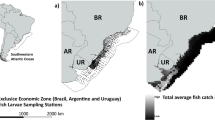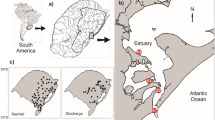Abstract
Understanding the interannual effect of various environmental factors on biodiversity distribution is fundamental for developing biological monitoring tools. The interannual variability of environmental factors on presettlement fish assemblages (PFAs) has been so far under investigated, especially in Madagascar. Numerous explanatory variables including local hydro-dynamic conditions recorded during the sampling night, characteristics of the benthic substrate and remotely sensed oceanic conditions (RSOC) were used to explain the spatio-temporal variability of PFAs in southwestern Madagascar. Gradient forest analyses were used to hierarchically classify the effect of these explanatory variables on the PFAs for two sites and during two different recruitment seasons. RSOC variables appeared to better explain the PFAs than the local variable and the characteristics of the benthic substrate. The PFAs caught in water masses with coastal characteristics were better explained than those with open water characteristics. This spatial variability is hypothesised to be linked to differences in feeding conditions among water masses. The gradient forest analyses also highlighted the complexity of predicting PFAs as the species for which abundances were better explained by RSOC variables varied between years. This interannual variability was mainly explained by the interannual variation of chlorophyll a (Chl a) concentration, wind and surface current, with better prediction obtained during the year with high Chl a values associated with high averaged sea surface temperature. These findings suggest the importance of forecasting Chl a concentrations, taking into account the impact of tropical storms and climate variability in order to predict PFAs in the future.









Similar content being viewed by others
References
Alizadeh MJ, Kavianpour MR, Kisi O, Nourani V (2017) A new approach for simulating and forecasting the rainfall-runoff process within the next two months. J Hydrol 548:588–597
Anderson MJ (2017) Permutational multivariate analysis of variance (PERMANOVA). In: Balakrishnan N, Colton T, Everitt B et al (eds) Wiley StatsRef: statistics reference online. Wiley, Chichester, pp 1–15
Brodeur R, Peterson W, Auth T, Soulen H, Parnel M, Emerson A (2008) Abundance and diversity of coastal fish larvae as indicators of recent changes in ocean and climate conditions in the Oregon upwelling zone. Mar Ecol Prog Ser 366:187–202
Carassou L, Le Borgne R, Rolland E, Ponton D (2010) Spatial and temporal distribution of zooplankton related to the environmental conditions in the coral reef lagoon of New Caledonia, Southwest Pacific. Mar Pollut Bull 61:367–374
Carassou L, Ponton D, Mellin C, Galzin R (2008) Predicting the structure of larval fish assemblages by a hierarchical classification of meteorological and water column forcing factors. Coral Reefs 27:867–880
Chassot E, Bonhommeau S, Dulvy NK, Mélin F, Watson R, Gascuel D, Pape OL (2010) Global marine primary production constrains fisheries catches. Ecol Lett 13:495–505
Chen L-C, Lan K-W, Chang Y, Chen W-Y (2018) Summer assemblages and biodiversity of larval fish associated with hydrography in the northern South China Sea. Mar Coast Fish 10:467–480
Chevalier C, Devenon J-L, Rougier G, Blanchot J (2015) Hydrodynamics of the Toliara Reef Lagoon (Madagascar): example of a lagoon influenced by waves and tides. J Coast Res 31:1403–1416
Cione JJ, Molina P, Kaplan J, Black PG (2000) SST time series directly under tropical cyclones: observations and implications. In: American Meteorolical Society. https://ams.confex.com/ams/last2000/webprogram/Paper12807.html. Accessed 28 May 2019
Clarke KR, Warwick RM, Laboratory PM (1994) Change in marine communities: an approach to statistical analysis and interpretation, 2nd edn. Plymouth marine laboratory, Natural environment research council
Cocheret de la Morinière E, Pollux BJA, Nagelkerken I, van der Velde G (2002) Post-settlement life cycle migration patterns and habitat preference of coral reef fish that use seagrass and mangrove habitats as nurseries. Estuar Coast Shelf Sci 55:309–321
Collet A, Durand J-D, Desmarais E, Cerqueira F, Cantinelli T, Valade P, Ponton D (2018) DNA barcoding post-larvae can improve the knowledge about fish biodiversity: an example from La Reunion, SW Indian Ocean. Mitochondrial DNA A DNA Mapp Seq Anal 29:905–918
Cooke A, Ratomahenina O, Ranaivosoin E, Razafindraibe H (2000) Madagascar. In: Sheppard CRC (eds) Seas at the millennium: an environmental evaluation. Amsterdam, pp 113–131
Dare RA, McBride JL (2011) Sea surface temperature response to tropical cyclones. Mon Weather Rev 139:3798–3808
Dumas P, Bertaud A, Peignon C, Léopold M, Pelletier D (2009) A “quick and clean” photographic method for the description of coral reef habitats. J Exp Mar Biol Ecol 368:161–168
Ellis N, Smith SJ, Pitcher CR (2012) Gradient forests: calculating importance gradients on physical predictors. Ecology 93:156–168
Emanuel K (2001) Contribution of tropical cyclones to meridional heat transport by the oceans. J Geophys Res Atmos 106:14771–14781
Ferrier S, Guisan A (2006) Spatial modelling of biodiversity at the community level. J Appl Ecol 43:393–404
Fisher R (2005) Swimming speeds of larval coral reef fishes: impacts on self-recruitment and dispersal. Mar Ecol Prog Ser 285:223–232
Folke C, Carpenter S, Walker B, Scheffer M, Elmqvist T, Gunderson L, Holling CS (2004) Regime shifts, resilience, and biodiversity in ecosystem management. Annu Rev Ecol Evol Syst 35:557–581
Hsieh C, Reiss C, Watson W, Allen MJ, Hunter JR, Lea RN, Rosenblatt RH, Smith PE, Sugihara G (2005) A comparison of long-term trends and variability in populations of larvae of exploited and unexploited fishes in the Southern California region: a community approach. Prog Oceanogr 67:160–185
INSTAT M, ICF M (2016) Enquête Démographique et de Santé de Madagascar 2008–2009. In: World Bank Microdata Library. https://microdata.worldbank.org/index.php/catalog/1435. Accessed on 08 July 2019
IOTC (2009) Madagascar National Report. In: Food and Agricultural Organizations of United Nations. https://iotc.org/documents/madagascar-national-report. Accessed 19 Mar 2019
Jaonalison H, Mahafina J, Ponton D (2016) Fish post-larvae assemblages at two contrasted coral reef habitats in Southwest Madagascar. Reg Stud Mar Sci 6:62–74
Jaonalison H, Durant J-D, Mahafina J, Demarcq H, Teichert N, Ponton D (2020) Predicting species richness and abundance of tropical post-larval fish using machine learning. Mar Ecol Prog Ser. https://doi.org/10.3354/meps13385
Kohler KE, Gill SM (2006) Coral point count with excel extensions (CPCe): a visual basic program for the determination of coral and substrate coverage using random point count methodology. Comput Geosci 32:1259–1269
Koslow JA, Davison PC (2016) Productivity and biomass of fishes in the California current large marine ecosystem: comparison of fishery-dependent and -independent time series. Environ Dev 17:23–32
Koslow JA, Wright M (2016) Ichthyoplankton sampling design to monitor marine fish populations and communities. Mar Policy 68:55–64
Le Borgne R, Blanchot J, Charpy L (1989) Zooplankton of tikehau atoll (Tuamotu archipelago) and its relationship to particulate matter. Mar Biol 102:341–353
Le Manach F, Gough C, Harris A, Humber F, Harper S, Zeller D (2012) Unreported fishing, hungry people and political turmoil: the recipe for a food security crisis in Madagascar? Mar Policy 36:218–225
Levin PS, Chiasson W, Green JM (1997) Geographic differences in recruitment and population structure of a temperate reef fish. Mar Ecol Prog Ser 161:23–35
Lin I, Liu WT, Wu C-C, Wong GTF, Hu C, Chen Z, Liang W-D, Yang Y, Liu K-K (2003) New evidence for enhanced ocean primary production triggered by tropical cyclone. Geophys Res Lett 30:1718
Lockwood SJ, Nichols JH, Dawson WA (1981) The estimation of a mackerel (Scomber scombrus L.) spawning stock size by plankton survey. J Plankton Res 3:217–233
Mahafina J (2011) Perception et comportement des pêcheurs pour une gestion durable de la biodiversité et de la pêcherie récifale du Sud-Ouest de Madagascar. Dissertation, University of La Réunion
Météo-France OI (2017) Bilan des activités cycloniques dans le bassin Sud-ouest de l’Océan Indien. In Cyclone Océan Indien. http://www.cycloneoi.com/archives-blog/cyclone/2016-2017-une-nouvellesaison-cyclonique-peu-active.html. Accessed on 30 April 2019
Morsink K (2018) Hurricanes, typhoons, and cyclones. In: Smithsonian Institution Ocean. https://ocean.si.edu/planet-ocean/waves-storms-tsunamis/hurricanes-typhoons-and-cyclones. Accessed 28 May 2019
Nagelkerken I, Kleijnen S, Klop T, van den Brand R, de la Morinière E, van der Velde G (2001) Dependence of Caribbean reef fishes on mangroves and seagrass beds as nursery habitats: a comparison of fish faunas between bays with and without mangroves/seagrass beds. Mar Ecol Prog Ser 214:225–235
Nichols JH, Bennett DB, Symonds DJ, Grainger R (1987) Estimation of the stock size of adult Nephrops norvegicus (L.) from larvae surveys in the western Irish Sea in 1982. J Nat Hist 21:1433–1450
Oksanen J, Blanchet FG, Friendly M, Kindt R, Legendre P, McGlinn D, Minchin PR, O’Hara RB, Simpson GL, Solymos P, Stevens MHH, Szoecs E, Wagner H (2019) Community ecology package. In: Cran r. https://cran.r-project.org/web/packages/vegan/index.html. Accessed on 29 April 2019
Olivar MP, Emelianov M, Villate F, Uriarte I, Maynou F, Álvarez I, Morote E (2010) The role of oceanographic conditions and plankton availability in larval fish assemblages off the Catalan coast (NW Mediterranean). Fish Oceanogr 19:209–229
Owen RW, Lo NCH, Butler JL, Theilacker GH, Alvariño A, Hunter JR, Watanabe Y (1989) Spawning and survival patterns of larval northern anchovy, Engraulis mordax, in contrasting environments-a site-intensive study. Fish Bull 87:673–688
Price JF, Morzel J, Niiler PP (2008) Warming of SST in the cool wake of a moving hurricane. J Geophys Res 113:C07010
R Core Team (2018) R: a language and environment for statistical computing. In: R Foundation for Statistical Computing. https://www.r-project.org/. Accessed on 11 June 2018
Rajaee T, Boroumand A (2015) Forecasting of chlorophyll-a concentrations in South San Francisco Bay using five different models. Appl Ocean Res 53:208–217
Ratnasingham S, Hebert PDN (2013) A DNA-based registry for all animal species: the barcode index number (BIN) system. PLoS One 8:e66213
Reynalte-Tataje DA, Zaniboni-Filho E, Bialetzki A, Agostinho AA (2012) Temporal variability of fish larvae assemblages: influence of natural and anthropogenic disturbances. Neotropical Ichthyol 10:837–846
Roubeix V, Daufresne M, Argillier C, Dublon J, Maire A, Nicolas D, Raymond J-C, Danis P-A (2017) Physico-chemical thresholds in the distribution of fish species among French lakes. Knowl Manag Aquat Ecosyst 418:1–14
Rousseaux CS, Gregg WW (2017) Forecasting ocean chlorophyll in the equatorial Pacific. Front Mar Sci 4:236
Smith JA, Miskiewicz AG, Beckley LE, Everett JD, Garcia V, Gray CA, Holliday D, Jordan AR, Keane J, Lara-Lopez A, Leis JM, Matis PA, Muhling BA, Neira FJ, Richardson AJ, Smith KA, Swadling KM, Syahailatua A, Taylor MD, van Ruth PD, Ward TM, Suthers IM (2018) A database of marine larval fish assemblages in Australian temperate and subtropical waters. Sci Data 5:180207
Takahashi M, Watanabe Y (2004) Growth rate-dependent recruitment of Japanese anchovy Engraulis japonicus in the Kuroshio-Oyashio transitional waters. Mar Ecol Prog Ser 266:227–238
Acknowledgements
Our acknowledgements going to the research assistants (J. J. Marcellin, D. Fiandria, R. Tsipy, Tovondrainy, and Noelson) for conducting fish sampling, and to the team of the ‘Institut des Sciences de l’Evolution de Montpellier’ (ISEM) for sequencing our fish tissues, and the Institut Halieutique et des Sciences Marines for issuing research permit. We also thank the three reviewers for their constructive remarks leading to the improvement our manuscript quality.
Funding
This work was co-funded by the French National Research Institute for Sustainable Development (JEAI-ACOM/IH.SM-IRD) in France, and the Critical Ecosystem Partnership Fund (MG-66341) in United States.
Author information
Authors and Affiliations
Corresponding author
Ethics declarations
Conflict of interest
The authors declare that they have no conflict of interest.
Ethical approval
All applicable international, national and/or institutional guidelines for the care and use of animals were followed by the authors.
Sampling and field studies
All necessary permits for sampling and observational field studies have been obtained by the authors from the competent authorities.
Data availability
The datasets generated during and/or analysed during the current study are available from the corresponding author on reasonable request.
Author contribution
HJ, JM, HD and DP conceived and designed research. HJ conducted fieldwork and labwork. HJ, JDD and DP performed specimen identification. HJ, RL and DP analyzed data. HJ wrote the manuscript. All authors read and approved the manuscript.
Additional information
Communicated by S. E. Lluch-Cota
Publisher’s note
Springer Nature remains neutral with regard to jurisdictional claims in published maps and institutional affiliations.
Rights and permissions
About this article
Cite this article
Jaonalison, H., Durand, JD., Mahafina, J. et al. Spatial and interannual variability of presettlement tropical fish assemblages explained by remote sensing oceanic conditions. Mar. Biodivers. 50, 52 (2020). https://doi.org/10.1007/s12526-020-01068-6
Received:
Revised:
Accepted:
Published:
DOI: https://doi.org/10.1007/s12526-020-01068-6




